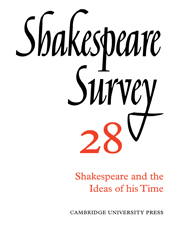Book contents
- Frontmatter
- ‘Richard II’ and the Realities of Power
- The Politics of Corruption in Shakespeare’s England
- Literature without Philosophy: ‘Antony and Cleopatra’
- Self-consciousness in Montaigne and Shakespeare
- ‘Measure for Measure’: The Bed-trick
- Shakespeare and the Doctrine of the Unity of Time
- ‘Coriolanus’ and the Body Politic
- ‘Titus Andronicus’, iii, i, 298–9
- ‘The Merchant of Venice’ and the Pattern of Romantic Comedy
- The Integrity of ‘Measure for Measure’
- ‘To Say One’: An Essay on ‘Hamlet’
- ‘The Tempest’ and King James’s ‘Daemonologie’
- Sight-lines in a Conjectural Reconstruction of an Elizabethan Playhouse
- The Smallest Season: The Royal Shakespeare Company at Stratford in 1974
- The Year's Contributions to Shakespearian Study 1 Critical Studies
- 2 Shakespeare’s Life, Times, and Stage
- 3 Textual Studies
- Index
- Plate section
‘To Say One’: An Essay on ‘Hamlet’
Published online by Cambridge University Press: 28 March 2007
- Frontmatter
- ‘Richard II’ and the Realities of Power
- The Politics of Corruption in Shakespeare’s England
- Literature without Philosophy: ‘Antony and Cleopatra’
- Self-consciousness in Montaigne and Shakespeare
- ‘Measure for Measure’: The Bed-trick
- Shakespeare and the Doctrine of the Unity of Time
- ‘Coriolanus’ and the Body Politic
- ‘Titus Andronicus’, iii, i, 298–9
- ‘The Merchant of Venice’ and the Pattern of Romantic Comedy
- The Integrity of ‘Measure for Measure’
- ‘To Say One’: An Essay on ‘Hamlet’
- ‘The Tempest’ and King James’s ‘Daemonologie’
- Sight-lines in a Conjectural Reconstruction of an Elizabethan Playhouse
- The Smallest Season: The Royal Shakespeare Company at Stratford in 1974
- The Year's Contributions to Shakespearian Study 1 Critical Studies
- 2 Shakespeare’s Life, Times, and Stage
- 3 Textual Studies
- Index
- Plate section
Summary
The beginning of act V, scene ⅱ finds Hamlet in a trough between action, released for once from the immediate stimuli of events. He is merely discussing his affairs with Horatio. It is a still moment, not with the felt danger of the moment that follows the acceptance of Laertes’ challenge, but freer, less constrained. Horatio reminds him gently that the English authorities must shortly report on the death of Rosencrantz and Guildenstern. And Hamlet responds with these words:
It will be short,
The interim’s mine, and a mans life’s no more
Then to say one.
That is what we have, and I reproduce it exactly in the terms that the Folio, our sole authority for this passage, supplies. ‘A man’s life’s no more than to say one.’ What does it mean? The editors – with, I think, a single major exception – pass the line by, its meaning being so obvious as to warrant no commentary. But I find that to explain the line, if I can, requires me to explain the play.
An editor can look the other way, but a translator cannot. We can usefully glance at two distinguished translations. Schlegel appears to stonewall successfully with 'Ein Menschenleben ist als zahlt mans eins': in fact he has given the phrase a decisive inclination, for 'zählen' is to count, not utter. Andre Gide makes this rendering even clearer:
Et la vie d'un homme ne laisse meme pas compter jusqu'à deux.
- Type
- Chapter
- Information
- Shakespeare Survey , pp. 107 - 116Publisher: Cambridge University PressPrint publication year: 1975
- 2
- Cited by



